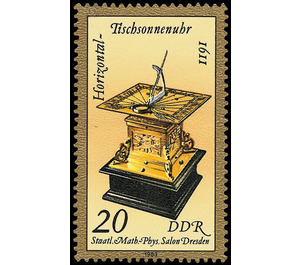Precious sand and sundials - Germany / German Democratic Republic 1983 - 20 Pfennig
Theme: Devices, Items & Instruments
| Country | Germany / German Democratic Republic |
| Issue Date | 1983 |
| Face Value | 20.00 |
| Color | brown |
| Perforation | K 14 |
| Printing Type | Rotogravure 2 |
| Stamp Type | Postage stamp |
| Item Type | Stamp |
| Chronological Issue Number | 2540 |
| Chronological Chapter | GER-DDR |
| SID | 973775 |
| In 25 Wishlists | |
Precious sand and sundials The Department of Postal and Telecommunications of the German Democratic Republic publishes six multicolored special postage stamps with images of sand and sundials from the State Mathematical-Physical Salon Dresden. Special cancellations from June 7 to August 6, 1983 Precious sand and sundials In the collection of watches of the State Mathematical-Physical Salon in the Dresden Zwinger, the sun and sand clocks from four centuries occupy a significant, much-acclaimed place. The history of the sundial, the oldest human timekeeping instrument, goes back well over 4,000 years, to ancient times in Egypt, China and Mesopotamia. In ancient times, sundials of various designs, including small portable instruments, were widely used, especially by Greeks and Romans. The "modern" sundial with earth-axes parallel polos, which indicates the same (equinoctial) hours, is an invention of the Arabs. It experienced its heyday in the 16th and 17th centuries. Variety, richness of forms, noble material and decorative design of sundials in master craftsmanship show the great interest that has been placed in these timepieces as objects of utility as well as representation in past centuries, especially in the Renaissance and Baroque periods. 20 Pfennig Value: Horizontal Table Sunglasses, 1611 Material: Brass, Fire-Gold Plated, Ebony; Height: 19 cm The table clock of the famous Dresden precision mechanic Christoph Trechsler is characterized by the fact that her dial with Poldreieck and compass by a kind of gimbal suspension always adjusts itself horizontally even when tilting the base. Hourglasses were widely used in Europe only since the 14th century. Their task was usually to measure shorter, fixed time periods, such as the duration of battle in knight tournaments, the length of lectures in universities and the plea in court hearings. Also, the glass in the shipping was done with the help of hourglasses. Best known, however, were the pulpit clocks that served in churches to measure and subdivide the sermon length.


